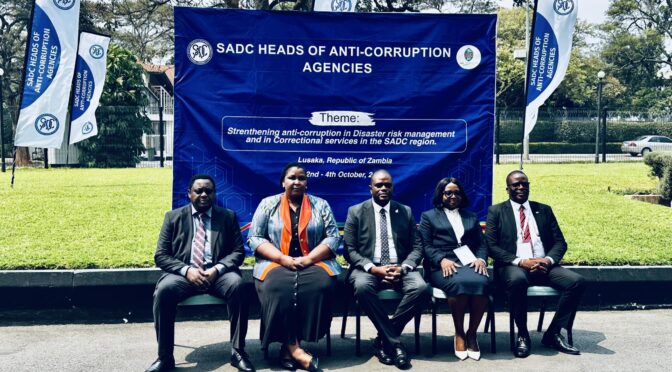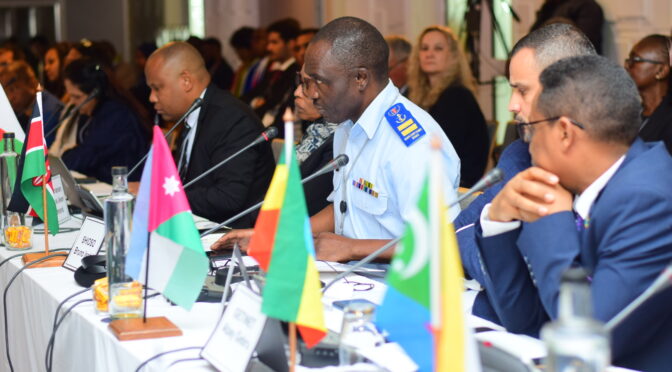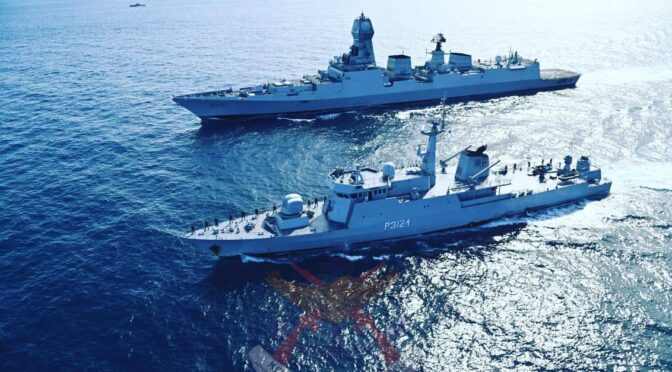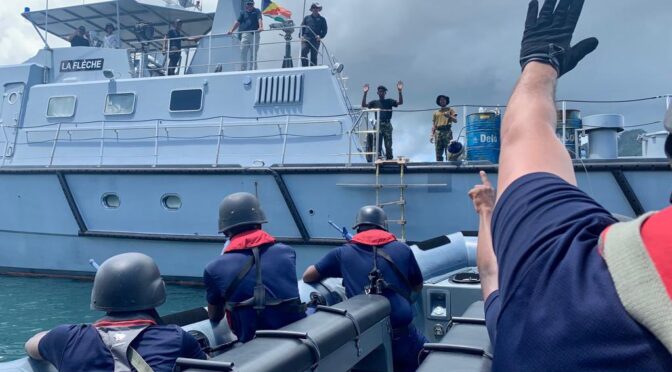By Mr. Timothy Walker, Institute for Security Studies, South Africa
Introduction
Developing robust regional maritime security mechanisms in Southern Africa necessitates greater emphasis on the Southern African Development Community’s (SADC) strategic oversight and operational capacity. This paper briefly charts SADC’s maritime security strategy and architecture, spotlighting relevant geographic features, institutions, and challenges that complicate implementation and member-state engagement. It will conclude by offering several policy recommendations that can bolster the implementation of the SADC Integrated Maritime Security Strategy (IMSS) in ways that complement existing structures and enhance multilateral efforts to improve maritime security.
SADC’s Institutional Framework
The Southern African Development Community is one of the eight Regional Economic Communities (REC) formally recognised by the African Union as a Regional Mechanism (RM) under the African Peace and Security Architecture (APSA) and thus entrusted with implementing continental peace and security mandates at the subregional level.1 The APSA Protocol (2002) names RECs/RMs—among them SADC—as key instruments enhancing African peace and security, acting in accordance with the principles of subsidiarity and complementarity
The United Nations Pact for the Future, adopted on September 22 2024, reinforces this mandate in Action 22 by calling on Member States to enhance cooperation at all levels to combat maritime threats and to promote information-sharing and capacity-building under international law.2 By combining APSA’s subsidiarity principle with the Pact’s regional focus, Action 22 should encourage SADC member states to consider strengthening its ability to pursue strategic partnerships—with other RECs, the AU Commission, and UN bodies—to secure technical assistance, harmonise maritime laws, and integrate its security agencies into broader continental and global efforts.
Institutionally, SADC has evolved and endured, although the fruits of its engagement at sea remain relatively modest. SADC most recently adopted an IMSS in 2022.3 This comprehensive strategy was developed through a collaborative effort involving most of its member states at some stage. The IMSS aligns with the African Union’s (AU) 2050 Africa Integrated Maritime Strategy and the AU African Peace and Security Architecture, aiming to facilitate collective efforts to address a broad spectrum of maritime threats such as drug trafficking, human trafficking, weapons smuggling, and illegal fishing.
The Standing Maritime Committee (SMC), established in 1995, has steered the drafting of SADC strategies.4 This is SADC’s formal maritime platform, open to all SADC member states. It was established to maximise maritime military cooperation across Southern Africa, ensure mutual security to keep sea lines of communication open, develop and sustain regional maritime capabilities, and build the capacity to respond rapidly to emerging contingencies. The SMC is one of the standing committees of the operations (Ops) Sub-Sub-Committee (SSC), which falls under the Defence Sub-Committee (DSC). The DSC, in turn, reports to the Inter-State Defence and Security Committee (ISDSC) as part of the SADC Organ on Politics, Defence, and Security Cooperation (OPDSC).5
This structure has significant institutional implications, as the SMC is situated three bureaucratic layers deep. Consequently, naval issues often lack direct representation at higher decision-making levels. As a result, concerns from the SMC may be overlooked since their recommendations must navigate through the Army/land forces-centric Defence Sub-Committee before reaching the ISDSC and, ultimately, the OPDSC. This multi-layered bureaucracy can hinder timely responses to maritime crises and delay solutions.
The broader impetus for serious African maritime strategies came after Somali piracy surged southwards in the late 2000s. In 2009, just months after the African Union Head of State Summit in Sirte recognised piracy off Somalia as a continental crisis, SADC defence chiefs began discussing a regional response.
Yet littoral states relied almost exclusively on the Djibouti Code of Conduct (adopted January 29 2009) rather than a unified SADC plan, as well as the Regional Coordination Operations Centre (RCOC), the Regional Maritime Information Fusion Centre (RMIFC) and the EU-funded MASE (Maritime Security) program to enable a cooperative, intelligence-led approach to maritime security in the Western Indian Ocean.6 Despite repeated attacks in SADC waters from 2008 onwards, meaningful action only accelerated once South Africa itself felt it was being targeted—by then, it appears it was too late to galvanize sustained regional commitment through SADC.
The 2019-2022 IMSS significantly improved the initial framework established in 2011, which focused mainly on addressing the threat of Somali piracy in the Mozambique Channel. After implementing its first Maritime Security Strategy (MSS) in 2011—primarily reflecting South Africa’s priorities and considered a temporary measure—SADC recognised the need for a comprehensive review and broader regional consultation in 2016. A concept paper was commissioned in 2018, a Review Work Group convened in 2019 to draft a fully integrated MSS, and the SADC IMSS was officially adopted in 2022.7 Meanwhile, transnational threats such as heroin trafficking along the “Southern Route,” human trafficking, arms smuggling, and illegal fishing increased, often being addressed by initiatives led by the United Nations Office on Drugs and Crime (UNODC) rather than through SADC mechanisms.8
The 2011 SADC MSS was never formally promulgated as an official public document; it was treated as a classified sub-committee report. SADC has not publicly invoked UN frameworks that could bolster its mandate, at least not publicly. A 2012 UN report noted that SADC could manage local piracy threats if it developed the necessary maritime resources – encouragement that seems to have had little impact. By missing an opportunity to align a regional initiative with global commitments, SADC did not strengthen its maritime governance or contribute to broader international maritime security objectives.
Analysis of SMC minutes suggests that the SMC’s performance has depended heavily on each Chief of Navy’s institutional knowledge and dynamism. Newcomers must build relationships and learn procedures, meaning each leadership change risks rolling back work on key tasks.
Attendance and continuity have varied: political instability, budget constraints, and suspensions have led to uneven participation and occasional gaps in leadership when rotating chairmanships left little time to carry forward initiatives. By 2016, SMC minutes still flagged the same 2011 priorities: a regional Maritime Domain Awareness Centre, dedicated MSS funding, a vessel-reporting framework, and a permanent MSS coordinator at headquarters – indicating significant stagnation. Moreover, attendance has waxed and waned, possibly reflecting mutual indifference.
SADC’s Geopolitical and Geographic Challenges
Consensus-based SADC decision-making must accommodate very different national interests. SADC comprises 16 diverse member states, among which are ten coastal and island countries.9 The territory of some of the six landlocked countries borders and includes several of Africa’s ‘Great Lakes’ and rivers/waterways. Landlocked SADC member states also depend on neighbouring ports and infrastructure for their imports and exports and security at sea to keep costs down and revenue up.
SADC’s maritime geography gives it several obstacles to navigate, gives rise to many external geopolitical interests, and makes regional maritime security a critical concern beyond the region. It is more than simply a case of being located astride a major global shipping route. Many post-colonial boundaries are not yet agreed to, and former colonial powers dispute sovereignty over several islands. Calls for enhanced security, management and jurisdiction over the region’s offshore oil and gas deposits and fisheries have made maritime boundary delimitation a growing concern.10 Continental-shelf claims, and rising sea levels add further layers of potential dispute over maritime boundaries, many of which remain unresolved.
Operation Copper
After attacks in the Mozambique Channel in December 2010, Mozambique requested South African naval support. Under a 2011 Memorandum of Understanding and later a trilateral 2012 agreement adding Tanzania, Operation Copper deployed South African Navy (SAN) frigates and South African Air Force (SAAF) maritime patrol aircraft to Cabo Delgado province in northern Mozambique.11 These continuous counter-piracy patrols were framed as being under a SADC mandate but were executed by South Africa, with only Mozambique (and briefly Tanzania) participating.12 Moreover, under Operation Vikela, the SAN Valour Class frigate SAS Spioenkop (F147), with a Maritime Reaction Squadron (MRS) element aboard, was able to conduct barrier coastal patrols in the same area of operation for the SAMIM from March to May 2022.13
Although South Africa annually renews Operation Copper (due to expire in 2026), planning and reporting remain confined to South Africa’s Department of Defence (DoD) planning and reporting cycles.14 Targets and indicators appear only in South Africa’s Annual Performance Plan and Annual Report each fiscal year. Although framed as following from a SADC mandate, planning, preparation and employment (and reporting) remain almost entirely confined to South Africa’s defence cycles and bureaucracy, limiting regional buy‑in and transparency as well as inclusion of lessons learned or good practices into SADC’s maritime peace operations doctrines.
South Africa has struggled to deploy any naval vessels in recent years, and the necessity of continuing a counter-piracy patrol in an area of operations beset by multiple other threats, including violent extremism and terrorism, is increasingly debated.
Overcoming Capacity Constraints
Most SADC navies operate ageing fleets on minuscule budgets yet are tasked with covering vast patrol areas. Many of these vessels are not easily interoperable. Language barriers and doctrinal differences further complicate joint exercises: the last purely SADC maritime drill (Golfinho) occurred in 2009, although several riverine and special-forces exercises have been held.15 Major maritime exercises have been led by external partners such as the US. The Indian Navy held its first major maritime exercise with African countries in April 2025.16
Regional experience in the Gulf of Guinea shows how a Combined Maritime Task Force (CMTF) can evolve from political endorsement to concrete operations. At its 1128th session (December 19 2022), the AU Peace and Security Council (PSC) welcomed efforts by naval chiefs in Port Harcourt to advance a Regional Maritime Task Force, marking a shift from policy talk to planning.17 This Task Force’s institutional development was aided by several Technical Committee meetings that laid out a Concept of Operations. Nigeria’s President Tinubu called in February 2025 for the AU to “prioritise the creation of a Combined Maritime Task Force”, and Nigeria’s offer to host its headquarters in Lagos further cemented political backing and resource pledges.18
While SADC has ratified and implemented regional fisheries and counter-terrorism agreements, their coordination with the standing maritime committee has lagged. A positive step is the Regional Fisheries Monitoring, Control and Surveillance Coordination Centre in Maputo, operational since April 2023, strengthening data sharing and enforcement against illegal, unreported and unregulated (IUU) fishing.19 This can be essential to creating a unified SADC Maritime Domain Awareness (MDA) Centre, which has been a standing item for almost two decades. EU’s Maritime Security (EU-funded) Program MASE and its Indian Ocean Regional Information System (IORIS) platform (developed under the Critical Maritime Routes Indo-Pacific [CRIMARIO] project), India’s Information Fusion Centre – Indian Ocean Region (IFC-IOR), and a range of private-sector Automatic Identification System (AIS) providers each collect, process, and share maritime data under different frameworks, technologies, and governance arrangements. As a result, national agencies and regional stakeholders receive overlapping but non-identical situational awareness feeds, leading to gaps, delays, and conflicting interpretations that can complicate joint SADC operations.
Conclusion
While most Southern Africans formally endorse regionalism in maritime security, few have made sustained investments in SADC institutions. Despite an institutional anchorage dating to the mid-1990s aligned with continental frameworks and norms for peace and security, as well as two formal strategies adopted in 2011 and 2022, respectively, SADC’s ability to secure its extensive Atlantic and Indian Ocean littorals and become a more robust regional maritime security mechanism have remained limited.
Mr. Timothy Walker is a Senior Researcher at ISS Pretoria. Since 2011, he has championed maritime security as a critical policy priority, collaborating in shaping strategies that protect Africa’s vital maritime interests with key organisations like the African Union, ECOWAS, IGAD, SADC, and IORA. Timothy holds a master’s in political and international studies from Rhodes University, South Africa.
References
“Africa India Key Maritime Engagement (AIKEYME) 2025 Inauguration.” Indian Ministry of Defence, April 13, 2025. https://pib.gov.in/PressReleasePage.aspx?PRID=2121521
“Annual Meeting of the Standing Maritime Committee.” South African Navy, March 13, 2023. http://www.navy.mil.za/Pages/Events/Annual-Meeting-Of-Standing-Maritime-Committee.aspx
“Communiqué: The 1128th Meeting of the AU Peace and Security Council (AUPSC) on Maritime Security in the Gulf of Guinea.” PSC/PR/COMM.1128 (2022), December 19, 2022. https://www.peaceau.org/en/article/communique-the-1128th-meeting-of-the-au-peace-and-security-council-aupsc-on-maritime-security-in-the-gulf-of-guinea
Edmond, Patrick, Kristof Titeka, and Erik Kennes. “The DRC–Angola Offshore Oil Dispute: How Regime (In)Security Outweighs Sovereign Claims.” Journal of Southern African Studies 45, no. 5 (September 2019): 1–17.
“Exercise Golfinho, an Example for other Continental Brigades.” ISS Today. Accessed May 5, 2025. https://issafrica.org/iss-today/exercise-golfinho-an-example-for-other-continental-brigades
Haldar, Sayantan. “Prioritising Maritime Domain Awareness in the Indian Ocean.” Observer Research Foundation Expert Speak, December 18, 2024. https://www.orfonline.org/expert-speak/prioritising-maritime-domain-awareness-in-the-indian-ocean
“Minister Sisulu signs Memorandum of Understanding (MOU) on Maritime Security Cooperation with Tanzania and Mozambique.” Government of South Africa, February 7, 2012. http://www.gov.za/news /media-statements/minister-sisulu-signs-memorandum-understanding-mou-maritime-security
“Maritime, Ports & Inland Waterways.” Southern African Development Community. https://www.sadc.int/pillars/maritime-ports-inland-waterways
Martin, Guy. “Operation Copper now only with SA and Mozambique.” defenceWeb, March 20, 2014. https://www.defenceweb.co.za/security/maritime-security/operation-copper-now-only-with-sa-and-mozambique/
Marti, Guy. “SANDF Denies SAMIDRC Mission was a Failure as Withdrawal Begins.” defenceWeb, May 4, 2025. https://www.defenceweb.co.za/featured/sandf-denies-samidrc-mission-was-a-failure-as-withdrawal-begins/
“Member States.” Southern African Development Community. https://www.sadc.int/member-states
“Mozambique duty for SAS Spioenkop.” defenceWeb, April 19, 2022. https://www.defenceweb.co.za/featured/mozambique-duty-for-sas-spioenkop/
“Nigeria Calls for Combined Maritime Task Force for the Gulf of Guinea at AU Summit; Navy to Provide Sea-lift Services.” State House Nigeria, February 16, 2025. https://statehouse.gov.ng/news/nigeria-calls-for-combined-maritime-task-force-for-the-gulf-of-guinea-at-au-summit-navy-to-provide-sea-lift-services/
“Operation Levante 2: A Regional Maritime Security Mission.” Indian Ocean Commission, August 26, 2024. https://www.commissionoceanindien.org/wp-content/uploads/2024/08/240823_Press-release-Levante2_ENG.pdf
“Pact for the Future.” Summit of the Future Outcome Documents. United Nations, September 2024. https://www.un.org/en/summit-of-the-future/pact-for-the-future
“Partnership to Counter Indian Ocean Drug Trafficking.” United Nations Office on Drugs and Crime. Accessed May 5, 2025. https://www.unodc.org/easternafrica/en/Stories/partnership-to-counter-indian-ocean-drug-trafficking.html
Porto, João Gomes and Ulf Engel. “Imagining, Implementing, and Integrating the African Peace and Security Architecture: The African Union’s Challenges.” African Security 7, no. 3 (July–September 2014): 135-146.
“Ramaphosa Extends Operation Copper Maritime Security Deployment.” defenceWeb, April 11, 2025. https://www.defenceweb.co.za/african-news/ramaphosa-extends-operation-copper-maritime-security-deployment/
“SADC.” ISS African Futures. Accessed May 5, 2025. https://futures.issafrica.org/geographic/recs/sadc/.
“The SADC Fisheries Monitoring, Control and Surveillance Coordination Centre – Set to Enter into Force in April 2023.” Stop Illegal Fishing, March 9, 2023. https://stopillegalfishing.com/news/the-sadc-fisheries-monitoring-control-and-surveillance-coordination-centre-set-to-enter-into-force-in-april-2023/
Walker, Timothy. “SADC’s Pursuit of Maritime Security in a Region Lacking Regionalism.” Scientia Militaria: South African Journal of Military Studies 47, no. 2 (June 2020): 51–68.
Wingrin, Dean. “South African Navy Calls for Regional Maritime Security Cooperation.” defenceWeb, September 11, 2024. https://www.defenceweb.co.za/featured/south-african-navy-calls-for-regional-maritime-security-cooperation/
Endnotes
[1] João Gomes Porto and Ulf Engel, “Imagining, Implementing, and Integrating the African Peace and Security Architecture: The African Union’s Challenges,” African Security 7, no. 3 (July–September 2014): 135-146.
[2] “Pact for the Future,” Summit of the Future Outcome Documents, United Nations, September 2024, https://www.un.org/en/summit-of-the-future/pact-for-the-future
[3] Dean Wingrin, “South African Navy Calls for Regional Maritime Security Cooperation,” defenceWeb, September 11, 2024, https://www.defenceweb.co.za/featured/south-african-navy-calls-for-regional-maritime-security-cooperation/
[4] Timothy Walker, “SADC’s Pursuit of Maritime Security in a Region Lacking Regionalism,” Scientia Militaria: South African Journal of Military Studies 47, no. 2 (June 2020): 51–68.
[5] “Annual Meeting of the Standing Maritime Committee,” South African Navy, March 13, 2023, http://www.navy.mil.za/Pages/Events/Annual-Meeting-Of-Standing-Maritime-Committee.aspx
[6] “Operation Levante 2: A Regional Maritime Security Mission,” Indian Ocean Commission, August 26, 2024, https://www.commissionoceanindien.org/wp-content/uploads/2024/08/240823_Press-release-Levante2_ENG.pdf
[7] Walker, “SADC’s Pursuit”, 62.
[8] “Partnership to Counter Indian Ocean Drug Trafficking,” United Nations Office on Drugs and Crime, accessed May 5, 2025, https://www.unodc.org/easternafrica/en/Stories/partnership-to-counter-indian-ocean-drug-trafficking.html
[9] “Member States,” Southern African Development Community, accessed May 5, 2025, https://www.sadc.int/member-states
[10] Patrick Edmond, Kristof Titeca, and Erik Kennes, “The DRC–Angola Offshore Oil Dispute: How Regime (In)Security Outweighs Sovereign Claims,” Journal of Southern African Studies 45, no. 5 (September 2019): 1–17.
[11] “Minister Sisulu signs Memorandum of Understanding (MOU) on Maritime Security Cooperation with Tanzania and Mozambique,” Government of South Africa, February 7, 2012, http://www.gov.za/news/media-statements/minister-sisulu-signs-memorandum-understanding-mou-maritime-security
[12] Guy Martin, “Operation Copper now only with SA and Mozambique,” defenceWeb, March 20, 2014, https://www.defenceweb.co.za/security/maritime-security/operation-copper-now-only-with-sa-and-mozambique/
[13] “Mozambique duty for SAS Spioenkop,” defenceWeb, April 19, 2022, https://www.defenceweb.co.za/featured/mozambique-duty-for-sas-spioenkop/
[14] “Ramaphosa extends Operation Copper maritime security deployment,” defenceWeb, April 11, 2025, https://www.defenceweb.co.za/african-news/ramaphosa-extends-operation-copper-maritime-security-deployment/
[15] “Exercise Golfinho, an Example for other Continental Brigades,” ISS Today, accessed May 5, 2025, https://issafrica.org/iss-today/exercise-golfinho-an-example-for-other-continental-brigades.
[16] “Africa India Key Maritime Engagement (AIKEYME) 2025 Inauguration,” Indian Ministry of Defence, April 13, 2025, https://pib.gov.in/PressReleasePage.aspx?PRID=2121521
[17] “Communiqué: The 1128th meeting of the AU Peace and Security Council (AUPSC) on Maritime Security in the Gulf of Guinea,” PSC/PR/COMM.1128 (2022), December 19, 2022, https://www.peaceau.org/en/article/communique-the-1128th-meeting-of-the-au-peace-and-security-council-aupsc-on-maritime-security-in-the-gulf-of-guinea
[18] “Nigeria Calls for Combined Maritime Task Force for the Gulf of Guinea at AU Summit; Navy to Provide Sea-lift Services,” State House Nigeria, February 16, 2025, accessed May 5, 2025, https://statehouse.gov.ng/news/nigeria-calls-for-combined-maritime-task-force-for-the-gulf-of-guinea-at-au-summit-navy-to-provide-sea-lift-services/
[19] “The SADC Fisheries Monitoring, Control and Surveillance Coordination Centre – Set to Enter into Force in April 2023,” Stop Illegal Fishing, March 9, 2023, https://stopillegalfishing.com/news/the-sadc-fisheries-monitoring-control-and-surveillance-coordination-centre-set-to-enter-into-force-in-april-2023/
Featured Image: Officials are pictured at a SADC anti-corruption event, 2024. (SADC photo)




